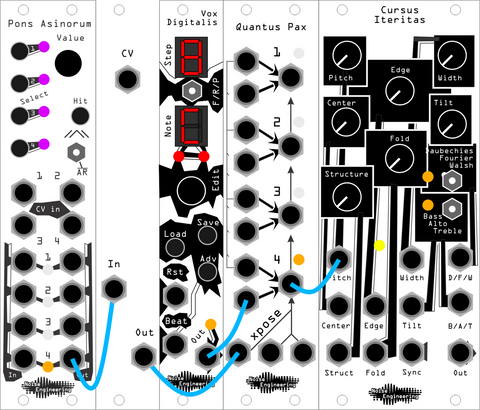Vibrato
Vibrato. It’s one of those things that sounds great on a violin, a cello, a guitar, you name it. But how can we get that sound out of our synth? Let’s discuss.
The concept
Vibrato is simply pitch modulation, or in synthesis terms, FM (frequency modulation). It’s a relatively simple concept, but like all musical techniques, it needs a bit of finesse. So what are we going to use to implement it?
The utilities
Let’s start super basic. To create the actual modulation, we’ll need an LFO. For these examples, I’ll be using Pons Asinorum in looping mode, but any LFO should work (one of my other favorites is Mutable Instruments Stages). We’ll also need some type of attenuation to keep our vibrato from going crazy. I’m going to use Sinc Defero. If your destination oscillator has separate 1v/8va and FM inputs, then this is all you need (in fact, you may not even need an attenuator in this case; my Rubicon 2, for example, has built-in FM attenuators). If your oscillator just has one frequency input (like many of ours), or you’re already using all its inputs for other things, we’ll need to patch it together. You’ll just need that attenuator and a precision adder like Quantus Pax or the Doepfer A-185-2.
Actually doing the thing
Now that we have our utilities together, let’s patch this thing. Here’s what we’re going for:

As you can see, we have our sequencer, Vox Digitalis, running into Quantus Pax. Our LFO, Pons Asinorum, is running through Sinc Defero, because we need to attenuate this a LOT. Why? Because PA’s output is 5 volts, and since we’re dealing with pitch, that would be a five-octave change. Too much! Generally vibrato is less than a semitone, so we need to change that 5 volt signal into something like 0.05 volts. Our attenuated LFO is running into an xpose input on Quantus Pax, our precision adder. The xpose inputs sum with all channels simultaneously, which will be handy for a later patch. Basically, this makes our pitch sequence wobbly. It kinda looks like this:

Fun stuff! There’s lots to experiment with even in a simple patch like this. For instance, your attenuator could be replaced by an attenuverter to invert the vibrato. This pulls the pitch down, instead of up, giving a different type of sound to it. You could also CV the frequency of your vibrato. This emulates a common technique used when playing actual stringed instruments and makes things sound more organic. PA’s CV ins are perfect for this! But what if we want to get a little bit MORE complicated?
Learn more:
More expression
What if we want to vary the amount of vibrato with CV? This is a handy patch, as controlling vibrato amount with a keyboard’s mod wheel or aftertouch is a common setup in fixed-architecture synths. Of course, since this is modular, we can use almost anything to control our vibrato amount. We can patch that up like this:

All we need to add is a DC-coupled VCA, like Intellijel’s uVCA. The CV input controls the amount of vibrato. Simple and fun!
Chord vibrato. Chorato? Vichordo? Chibrato?
Probably my favorite patch here: one of the reasons I love QP is its xpose inputs. Since we can apply modulation to all four channels simultaneously, we can add vibrato to a chord. I like to use Mimetic Digitalis to create chords: I’ll program in a different chord on each step and then CV through them with another sequencer (we talk about this in our MD for Presets post). We can then run its four outputs through QP, applying vibrato, then send the four outputs to our destination oscillators.

Super musical! Let’s hear what this actually sounds like. Lapsus Os controls our vibrato amount, and Pons Asinorum provides the actual vibrato-ing:
Show us what you got!
If you make a cool patch with the techniques we talk about here, tag us on instagram! We love seeing what you’re making.





